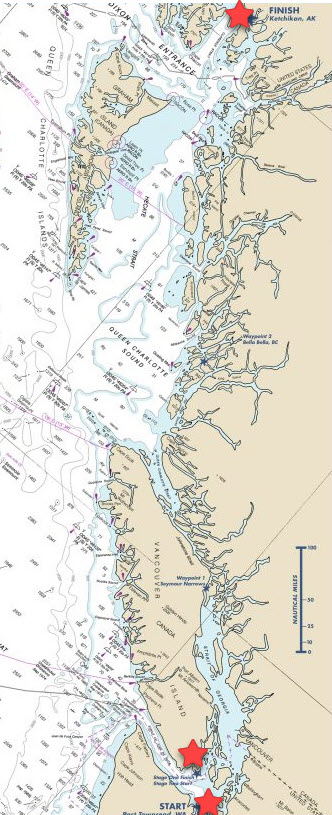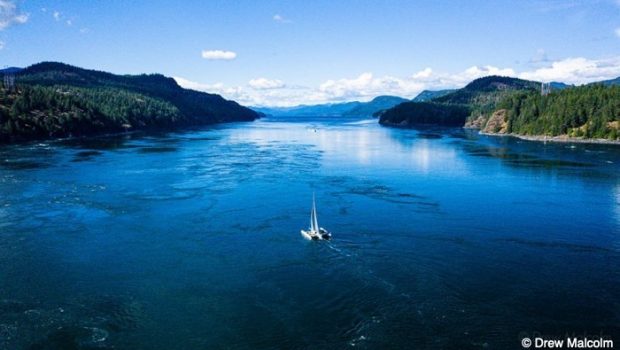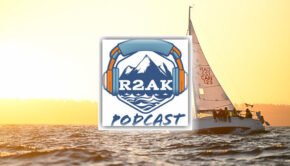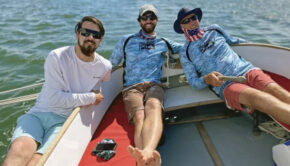R2AK: Seymour is a reckoning force
Published on June 8th, 2019
The 5th edition of the 750 mile Race to Alaska began with a 40-mile stage from Port Townsend, WA to Victoria, BC before the entrants are permitted to continue on to Ketchikan, AK. Stage 2 is underway, 710 miles from Victoria to Ketchikan, Alaska.
(June 8, 2019) – Unless you’re Joseph Heller or that crazy guy on the corner, stories are expected to be chronological. Establish a reality, create affinity with the protagonists, introduce conflict, create some sort of climax, and then resolve everything by the end of the third act.
These things have rules. To the ‘Cant. Stop. Watching.’ chagrin of the bleary eyed tracker fans and families of anyone in the northern third of the race, Day 2 was almost over before it got started.
Yesterday TLDR’d sunrise to sunset and fast forwarded to the cluster run of Seymour Narrows as nature applauded the third/opening act with the pink-for-forever, sky-on-fire sunset with no less than eight teams hitting the first tidal gate at Seymour.
For the new kids in the class, more than the first of two checkpoints teams are required to pass through, Seymour Narrows is the legendary passage that is spoken in hushed tones that are equal parts frightened and reverential. Midway up the inside of VanIsle, Seymour Narrows is more or less the battleground where rising tides from the northern Queen Charlotte Sound collide with the waters of the Strait of Georgia. 100+ miles of water in each direction pulled by the cosmic force, gravity of the sun and moon, and forced through a channel slightly less than 750 meters wide.
It’s a hydrodynamic rugby scrum between north and south, an oceanic pendulum that swings from stop to stop at a velocity of upwards of 15 knots…or something like that. Regardless of our best swing metaphors that clock in at less than adequate, Seymour is a force to be reckoned with.
George Vancouver logged it as “one of the vilest pieces of water in the world,” and even after the largest non-nuclear explosion was engineered to make it less horrible by removing the worst of it, even cruise ships that pack 10,000+ horsepower into their bow thrusters alone still make a point to get through Seymour when the current is theoretically slack.
For the R2AK’s pedal-powered set, unless the wind is howling the Narrows is a gate that closes when the water goes the wrong way. Miss the gate, you wait until it opens again—even if you’re Team Pear Shaped Racing and well in the lead on a high performance trimaran. The Pears were handily ahead. They had gotten into clear air the night before and gone from slightly behind to well in front of the downwind engine of Team Angry Beaver. Not an over-the-horizon runaway, but they steadily increased the gap between them and anyone/everyone behind them.
Then the tide turned, the gate slammed closed, and Seymour’s aquatic treadmill kept increasing speed in the wrong direction until the Pear Shapes had to admit that despite their sailing faster than anyone, their boat was going nine knots to nowhere. Time to take a number and wait.
At the same time, lower in the course the sun was shining on a downwind run that sent the chase pack north at closing speed; licking their chops and bunching up like your oldest pair of underwear on a sweaty jog. Teams Givin’ the Horns and Angry Beaver worked what back eddy there was on Campbell River’s far shore—stemming the tide at sometimes as little as a couple of knots toward the gate but more than the leader was able to make as they waited for the tide to turn.
Not far behind, Team Sail Like a Girl showed their champion streak and had clawed back to close enough and were matching tacks with the global talent of Team Shut Up and Drive, all the while fending off solid PNW trimaran sailors on Teams Trickster and Narwhal.
It’s hard not to personify the tide table predicted, yet somehow random, nature of this year’s gambit at the Narrows. In years past, the leaders have tended to fly through before the gate slammed shut on the rest, giving a ‘rich get richer’ lead to the first ones through; playing a less than egalitarian role in deciding who got the money and who had to fight it out for the steak knives.
This seems to be an Occupy Seymour year, with the Narrows showing a Marxist streak and doing their best to level the field; playing the role of the fair-minded parent who measures out the sugar cereal so the kids won’t “IT’S NOT FAIR” when all that was left was the dregs and the oat bran.
Seymour Narrows: “Now wait for the others dear…”
Team Pear Shaped Racing: *kicks rocks*
Overnight, Johnstone Strait, R2AK’s other sometimes sentinel antagonist, appears to have offered only a half-hearted shadow of the angry god playpen it’s been for teams in the past. Saturday night winds clocked in far shy of the 40 knot gales that routinely rage against Johnstone’s serious tides in what amounts to a ‘hold my beer’ reminder to Juan de Fuca of how the pros do it.
That much wind against that much current; in past years the square-headed mountains of froth it’s created has littered its shores and these write ups with broken boats and sunken spirits; masts have snapped, rudders broken, carnage stacking up of all kinds and teams coming to their senses. This year, with winds predicted at 15 knots diminishing to 10, it’s more like the guy at the haunted house who just can’t get into character. “Boo, or whatever.”
As the day dawns and the curtain closes on Day 2, Team Pear Shape’s superior boat speed has put some distance between itself and number two, but with Team Givin’ the Horns close behind, Team Angry Beaver on the dark side of the tracker (yes, we think it’s annoying too), and five more through the gate—who knows what the day will bring.
36 hours into Stage Two, and the lead pack has been forced into a restart—eight teams through on the the first tidal gate (the most ever), two more teams on the next, and with 500+ miles to go, this looks like the race-iest Race to Alaska that we’ve ever had.
24 Hour Fact Sheet
• 12 teams are through the Narrows as of publication time
• 284 miles between first and last place
• R2Ache made it to graduation, cheers!
Comparison of time it took leaders to get to Seymour Narrows:
• 25 hours in 2016 for Mad Dog Racing
• 33.5 hours for Pear Shaped Racing
• 36 hours in 2017 Freeburd/Pure & Wild
Here’s their first, and it spans the stories from the Soviet National Anthem to the end of Stage One.
Race details – Team list – Tracker – Facebook – Instagram
 Background:
Background:
Race to Alaska, now in its 5th year, follows the same rules which launched this madness. No motor, no support, through wild frontier, navigating by sail or peddle/paddle (but at some point both) the 750 cold water miles from Port Townsend, Washington to Ketchikan, Alaska.
To save people from themselves, and possibly fulfill event insurance coverage requirements, the distance is divided into two stages. Anyone that completes the 40-mile crossing from Port Townsend to Victoria, BC can pass Go and proceed. Those that fail Stage 1 go to R2AK Jail. Their race is done.
Stage 1 Race start: 0500 June 3rd, Port Townsend, Washington
Stage 2 Race start: 1200 June 6th, Victoria, BC
There is $10,000 if you finish first, a set of steak knives if you’re second. Cathartic elation if you can simply complete the course. R2AK is a self-supported race with no supply drops and no safety net. Any boat without an engine can enter.
Last year 37 teams were accepted and 21 finished.
Source: Race to Alaska







 We’ll keep your information safe.
We’ll keep your information safe.